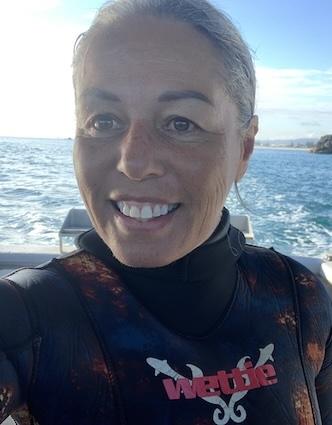
In 2007 Te Rūnanga o Ngāti Awa approached Professor Kura Paul-Burke (Ngāti Awa, Ngāti Whakahemo, Ngāti Mākino, Irish) because they suspected the mussel population was declining and it needed more information.
Kura asked her father for advice on how to approach the research because the request came from her own iwi and she wanted to adopt a Māori-led approach, rather than use a traditional Western scientific method. “My daddy told me to start with the old people and what they knew from their experience of the harbour. So, the very first thing we did was launch our boat with our tohunga, our kaumātua and kuia on board and we asked them where they collected shellfish when they were young.”
From here Kura carried out GPS mapping of the historic kuku (green-lipped mussel) beds and she says that historic information was invaluable because it identified the traversing of three or four generations of knowledge in one boat trip. Kura then established an ecological baseline by diving all the mussel sites in the harbour, and this was crucial because it established a longitudinal picture that sat alongside the historical mātauranga baseline provided by kaumātua.
Over the next two years, researchers witnessed the mussel beds undertake a devastating decline to such a state that only one mussel bed remained in 2009, and by 2019 it had completely disappeared. “Instead of mussels, we saw a harbour floor that was completely covered in orange starfish. While the starfish looked pretty, they were devouring the mussels and that was telling us the harbour ecosystem was completely out of balance,” says Kura.
What was to follow were years of trial and error, experiments, and use of mātauranga to restore mussel beds back. The first major problem to solve was how to best manage the starfish, many of which were too tiny for divers to see, let alone capture. “We also knew we couldn’t just remove all of the starfish, because they are a keystone species which the harbour actually needs, they have their own mana and mauri, so we had to be very thoughtful about them, while at the same time trying to maintain a balanced ecosystem,” says Kura.
Inspired by her nephew’s crab trap built from a bicycle wheel, Kura trialled a variety of methods and eventually the team landed on one extremely potent starfish trap. The next question was what to do with the captured starfish? Kura approached colleagues from the Cawthron Institute and Plant & Food Research who knew that starfish are very high in collagen. The idea of hand cream materialised and was put into production. “We made starfish hand cream which all the aunties loved. So we were able to create something positive from the starfish, and any profits could be put back into the harbour creating a circular economy,” says Kura.
With one problem solved, plenty more were to follow. The research team had to reinstate the mussel beds in places that would be most optimal for their thriving. After undertaking ecological mapping, Kura was not surprised to learn that the modern ecological predictor aligned perfectly with what kaumātua had already identified on that very first boat trip.
With an aversion to using plastic for mussel spat lines, Kura enlisted the help of tohunga, Whaea Rokahurihia Cameron (Te Whānau-ā-Apanui, Ngati Awa) to experiment with weaving a variety of natural fibres, including harakeke, tī kōuka leaves, and pīngao into mussel spat lines and trialing which ones lasted the longest in the water.
“We found that tī kōuka was the best and that’s not surprising because historically our tīpuna used it for kai, for raincoats, fire starters, and roof materials. That’s how neat our tīpuna were. They knew some stuff!”
It’s been nearly two decades since that first boat ride to survey the Ōhiwa Harbour with her old people, and since then, most of the kaumātua on that original trip have passed away, including Kura’s dad. Over a decade of research, experimentation and hard work, the mussel beds in the Ōhiwa Harbour are now bouncing back with over 16 million mussels now thriving on the seafloor. No other mussel restoration project in the country has been able to achieve these exciting results.
Another positive outcome has been the capacity building of young people. Today, Kura leads a team of young, determined wāhine Māori PhD marine science students, all who whakapapa to Ōhiwa Harbour. One PhD student is a NPM scholarship recipient, Kiri Reihana, who is trying to understand the reasons for the declining cockle population in the harbour. Kura has also been responsible for inspiring and teaching Ngāti Awa taiohi to free dive and to care for their harbour using mātauranga Māori techniques.
“They are passionate, energetic, clever and funny. Being involved in the project has inspired some of the taiohi to go on to learn te reo Māori and continue their education. Some of them have also taken up marine studies as a result,” she says.
“Succession is everything. I love working with passionate young people who care about their harbour and their ocean. Exploring innovative ways to prioritise mātauranga Māori into pragmatic restoration effort across generations is amazing mahi. I see my role as smoothing the pathway for the future marine leaders of tomorrow,” says Kura. See more about Kura’s amazing research and why she is the 2024 Local Hero Winner Blue Marine Foundation Award:
https://www.rnz.co.nz/programmes/turning-the-tide/story/2018942671/turn… episode-2-matauranga-led-restoration
https://www.youtube.com/watch?v=ok8QcS9m3Dk RANGAHAU | RESEARC